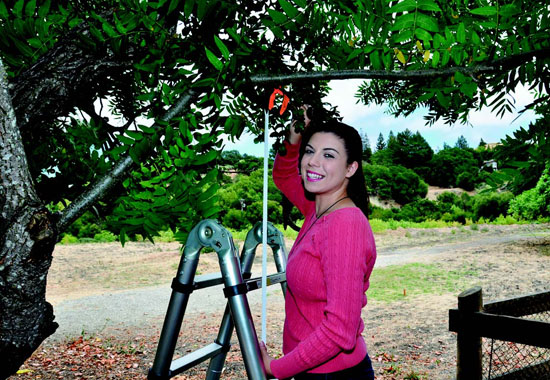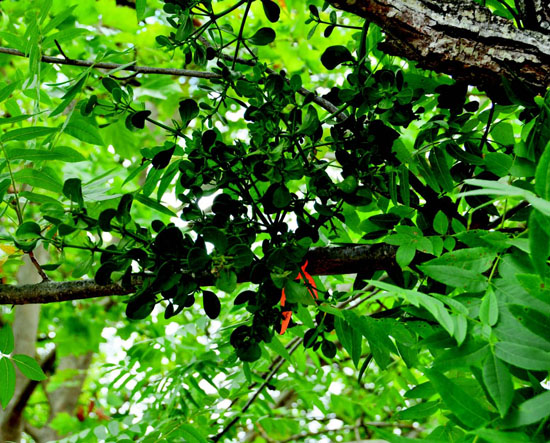 | | | Courtney Starr checks the size of this mistletoe in Lamorinda. Photo Andy Scheck | | | | | | When biology major Courtney Starr began making plans for summer research, she didn't expect she'd spend June through August surrounded by an iconic symbol of Christmas, but that's exactly what is happening for this Saint Mary's junior. In collaboration with Anthony Talo, Ph.D., a professor of biology at Saint Mary's College, Starr is plucking, grinding and analyzing mistletoe from all around the Lamorinda area.
 "There's actually a lot of mistletoe in Lamorinda," said Starr, noting that the term covers a wide swath of plant life (up to some 1,300 species). Starr and Talo are focusing on the three to four that grow closest to home, primarily on one called Phoradendron macrophyllum. "We're looking at the distribution of different genetic subspecies," said Starr, "and how they vary by location."
"There's actually a lot of mistletoe in Lamorinda," said Starr, noting that the term covers a wide swath of plant life (up to some 1,300 species). Starr and Talo are focusing on the three to four that grow closest to home, primarily on one called Phoradendron macrophyllum. "We're looking at the distribution of different genetic subspecies," said Starr, "and how they vary by location."
 Inspiration for the project came from Talo's day-to-day life. "One of my goals is to develop undergraduate research," he said. As he drove back and forth to work, clusters of mistletoe bulging from leafless deciduous trees repeatedly caught Talo's attention. "I thought 'there's got to be an [undergraduate] project there.'" Though there are clusters of mistletoe throughout California, Talo noted that the ones in Lamorinda are particularly sizable. Enough so to warrant some exploration.
Inspiration for the project came from Talo's day-to-day life. "One of my goals is to develop undergraduate research," he said. As he drove back and forth to work, clusters of mistletoe bulging from leafless deciduous trees repeatedly caught Talo's attention. "I thought 'there's got to be an [undergraduate] project there.'" Though there are clusters of mistletoe throughout California, Talo noted that the ones in Lamorinda are particularly sizable. Enough so to warrant some exploration.
 "One question I was interested in was how related mistletoe are within a tree and between trees as well. In theory, all of it should be related but what you have are little islands [of mistletoe] per tree and potentially what we would see is speciation between trees, eventually becoming so different they would not interbreed."
"One question I was interested in was how related mistletoe are within a tree and between trees as well. In theory, all of it should be related but what you have are little islands [of mistletoe] per tree and potentially what we would see is speciation between trees, eventually becoming so different they would not interbreed."
 As an obligate stem hemiparasite, mistletoe seeds are typically carried through bird droppings that transfer the mistletoe from one clump of trees to another. Once a seed makes its way to a host tree, it sticks in a haustorium (basically a dual-acting anchor-straw) from which it draws nutrients and water. It then spends its entire life attached to the host. As opposed to a holoparasite, which is incapable of contributing to its own survival, mistletoe takes in energy and produces food through photosynthesis. It has been found on a variety of trees, with different species of mistletoe preferring different hosts.
As an obligate stem hemiparasite, mistletoe seeds are typically carried through bird droppings that transfer the mistletoe from one clump of trees to another. Once a seed makes its way to a host tree, it sticks in a haustorium (basically a dual-acting anchor-straw) from which it draws nutrients and water. It then spends its entire life attached to the host. As opposed to a holoparasite, which is incapable of contributing to its own survival, mistletoe takes in energy and produces food through photosynthesis. It has been found on a variety of trees, with different species of mistletoe preferring different hosts.
 Starr and Talo have found that the pockets of mistletoe that grow on host trees near Mt. Diablo are a different species from those that grow on the trees at Saint Mary's. They are trying to figure out just how different those two species are, basically asking whether or not the populations share a common ancestor. "They could have started as one type and then adapted to their environments, forming different preferences and traits," said Starr, excited by the idea of seeing evolution in process.
Starr and Talo have found that the pockets of mistletoe that grow on host trees near Mt. Diablo are a different species from those that grow on the trees at Saint Mary's. They are trying to figure out just how different those two species are, basically asking whether or not the populations share a common ancestor. "They could have started as one type and then adapted to their environments, forming different preferences and traits," said Starr, excited by the idea of seeing evolution in process.
 Starr and Talo are focusing on the population(s) closest to Saint Mary's campus, but are also taking samples from other clusters in the area. The project has taken them to Briones Regional Park, the Moraga Commons, the Oursan Trail, and the Lafayette Reservoir. "[The mistletoe] is readily available for research," Starr noted. She gathers samples every one to two days. So far she and Talo have collected 50, roughly half of their goal for the summer-long project.
Starr and Talo are focusing on the population(s) closest to Saint Mary's campus, but are also taking samples from other clusters in the area. The project has taken them to Briones Regional Park, the Moraga Commons, the Oursan Trail, and the Lafayette Reservoir. "[The mistletoe] is readily available for research," Starr noted. She gathers samples every one to two days. So far she and Talo have collected 50, roughly half of their goal for the summer-long project.
 When they aren't out collecting samples, they're in the lab analyzing them. Starr extracts the DNA from the mistletoe, grinding her samples and using chemicals and a centrifuge to pull strands of DNA from the rest of the plant cell. She then performs a Polymerase Chain Reaction (PCR) to replicate the DNA, amplifying the specific region of DNA she's trying to compare. Starr does this with all of her samples, comparing the DNA coding from one population to the next and evaluating whether or not it differs by location.
When they aren't out collecting samples, they're in the lab analyzing them. Starr extracts the DNA from the mistletoe, grinding her samples and using chemicals and a centrifuge to pull strands of DNA from the rest of the plant cell. She then performs a Polymerase Chain Reaction (PCR) to replicate the DNA, amplifying the specific region of DNA she's trying to compare. Starr does this with all of her samples, comparing the DNA coding from one population to the next and evaluating whether or not it differs by location.
 Starr and Talo's summer mistletoe collections and analysis, which focus on the mistletoe in Moraga, will continue until the last week in August. In October, Starr will give a poster presentation at Saint Mary's. She and Talo may also publish a paper, depending on their findings. Talo hopes to broaden the research going forward, looking at samples from populations throughout Contra Costa and Alameda counties. Starr may be a part of that additional research, though mistletoe isn't what got her interested in biology.
Starr and Talo's summer mistletoe collections and analysis, which focus on the mistletoe in Moraga, will continue until the last week in August. In October, Starr will give a poster presentation at Saint Mary's. She and Talo may also publish a paper, depending on their findings. Talo hopes to broaden the research going forward, looking at samples from populations throughout Contra Costa and Alameda counties. Starr may be a part of that additional research, though mistletoe isn't what got her interested in biology.
 "I'm actually interested in animal biology," Starr said. "But doing the research on [something like] this gives you a background; starting small and working toward something more complex."
"I'm actually interested in animal biology," Starr said. "But doing the research on [something like] this gives you a background; starting small and working toward something more complex."
 "I can't think of a better way to do science," Talo said of the faculty-student project. "It's a very one-on-one relationship. We have good students who really want to do good research."
"I can't think of a better way to do science," Talo said of the faculty-student project. "It's a very one-on-one relationship. We have good students who really want to do good research."

|

